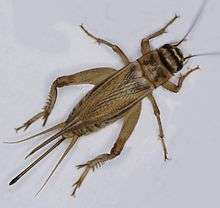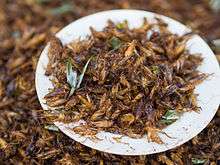House cricket
Acheta domesticus, commonly called the house cricket, is a cricket most likely native to Southwestern Asia, but between 1950 and 2000 it became the standard feeder insect for the pet and research industries and spread worldwide.[2][3] but can be kept as pets themselves, as this has been the case in China and Japan.[4]
| House cricket | |
|---|---|
 | |
| Scientific classification | |
| Kingdom: | Animalia |
| Phylum: | Arthropoda |
| Class: | Insecta |
| Order: | Orthoptera |
| Suborder: | Ensifera |
| Family: | Gryllidae |
| Genus: | Acheta |
| Species: | A. domesticus |
| Binomial name | |
| Acheta domesticus | |
| Synonyms | |
| |
Description
The house cricket is typically gray or brownish in color, growing to 16–21 millimetres (0.63–0.83 in) in length. Males and females look similar, but females will have an ovipositor emerging from the rear, around 12 millimetres (0.47 in) long. The ovipositor is brown-black, and is surrounded by two appendages. On males, the cerci are also more prominent.[5]
Life cycle
House crickets take two to three months to complete their life cycle at 26 to 32 °C (79 to 90 °F). They have no special overwintering stage, but can survive cold weather in and around buildings, and in dumps where heat from fermentation may sustain them. Eggs are deposited in whatever damp substrate is available. Juveniles resemble the adults except for being smaller and wingless.[2]
Diseases
The house cricket was essentially eliminated from the cricket-breeding industries of North America and Europe by the appearance of cricket paralysis virus which spread rapidly in Europe in 2002 and then in the United states in 2010. The virus is extremely lethal to this species of cricket and a few others, and left many hobbyists and researchers without adequate feeder insects. It has been replaced by the Jamaican field cricket, which is resistant to cricket paralysis virus and has many of the desirable features of the house cricket.[6]
Human consumption

The house cricket is an edible insect. It is farmed in South-East Asia and parts of Europe and North America for human consumption. In Asia it is said to become more popular than many native cricket species due to what consumers claimed was their superior taste and texture.[7] Dry-roasting is common and is considered the most nutritious method of preparing them, though they are often sold deep-fried as well.[8][9] Farmed house crickets are mostly freeze-dried and often processed into a powder known as cricket flour.[10] In Europe, the house cricket is officially approved for use in food products in Switzerland (since 2017).[11]
Nutrition
Like all insects, crickets are a complete protein. They contain both omega-3 and omega-6 fatty acids.[12]
|
Serving size: 1 1/2 cup (30g) | ||
| Quantity per Serving | ||
|---|---|---|
| Calories | 150 | |
| Total Fat | 6 | g |
| Saturated fat | 2.3 | g |
| Trans fat | 0.05 | g |
| Cholesterol | 50 | mg |
| Sodium | 100 | mg |
| Total Carbohydrate | 6 | g |
| Dietary Fiber | 6 | g |
| Protein | 18 | g |
| Vitamin D | 0.22 | |
| Vitamin B12 | 0.86 | µg |
| Calcium | 38.5 | mg |
| Iron | 1.6 | mg |
| Potassium | 273 | mg |
References
- "Acheta domesticus" at the Encyclopedia of Life
- Walker TJ. (2007). "House cricket, Achetus domesticus". Featured Creatures. University of Florida/IFAS.
- Galloway, Vickie (January 1998). "Raising Crickets". Scarabogram. Scarabs: The Bug Society (213): 2–3. Archived from the original on 2004-06-23. Retrieved 2010-07-08.
- Kulzer, Louise (March 1998). "House Crickets". Scarabogram. Scarabs: The Bug Society (215): 2–4. Archived from the original on 2012-05-11. Retrieved 2010-07-08.
- "Breeding Crickets". Herp Center. Retrieved 2010-07-08.
- Rosemary Parker (19 January 2012). "Following Cricket Paralysis Virus catastrophe, Top Hat Cricket Farm in Portage rebuilds it business". Michigan Live.
- Here's Why You Should Start Eating (More) Bugs https://www.huffingtonpost.com/2014/02/10/eating-bugs-food_n_4726371.html?slideshow=true#gallery/310345/0 Archived 10 February 2018 at the Wayback Machine
- http://www.fao.org/docrep/017/i3246e/i3246e.pdf
- https://www.cnet.com/news/edible-insects-crickets-mealworms-farm-protein/
- http://fortune.com/2014/07/18/bugs-in-your-protein-bar-are-edible-insects-the-next-food-craze/
- Bundesamt für Lebensmittelsicherheit und Veterinärwesen (2017-04-28): "Insects as food" (German only)
- https://www.huffingtonpost.com/marlon-doll/five-reasons-to-eat-crick_b_13939920.html
- http://www.aketta.com/about-aketta.aspx
- https://criknutrition.com/pages/why-cricket-protein-powder
- http://insectsarefood.com/faq.html
- Schmidt, Anatol; Call, Lisa; Macheiner, Lukas; Mayer, Helmut K. (2018). "Determination of vitamin B12 in four edible insect species by immunoaffinity and ultra-high performance liquid chromatography". Food Chemistry. 281: 124–129. doi:10.1016/j.foodchem.2018.12.039. PMID 30658738.
External links
| Wikispecies has information related to Acheta domesticus |
![]()